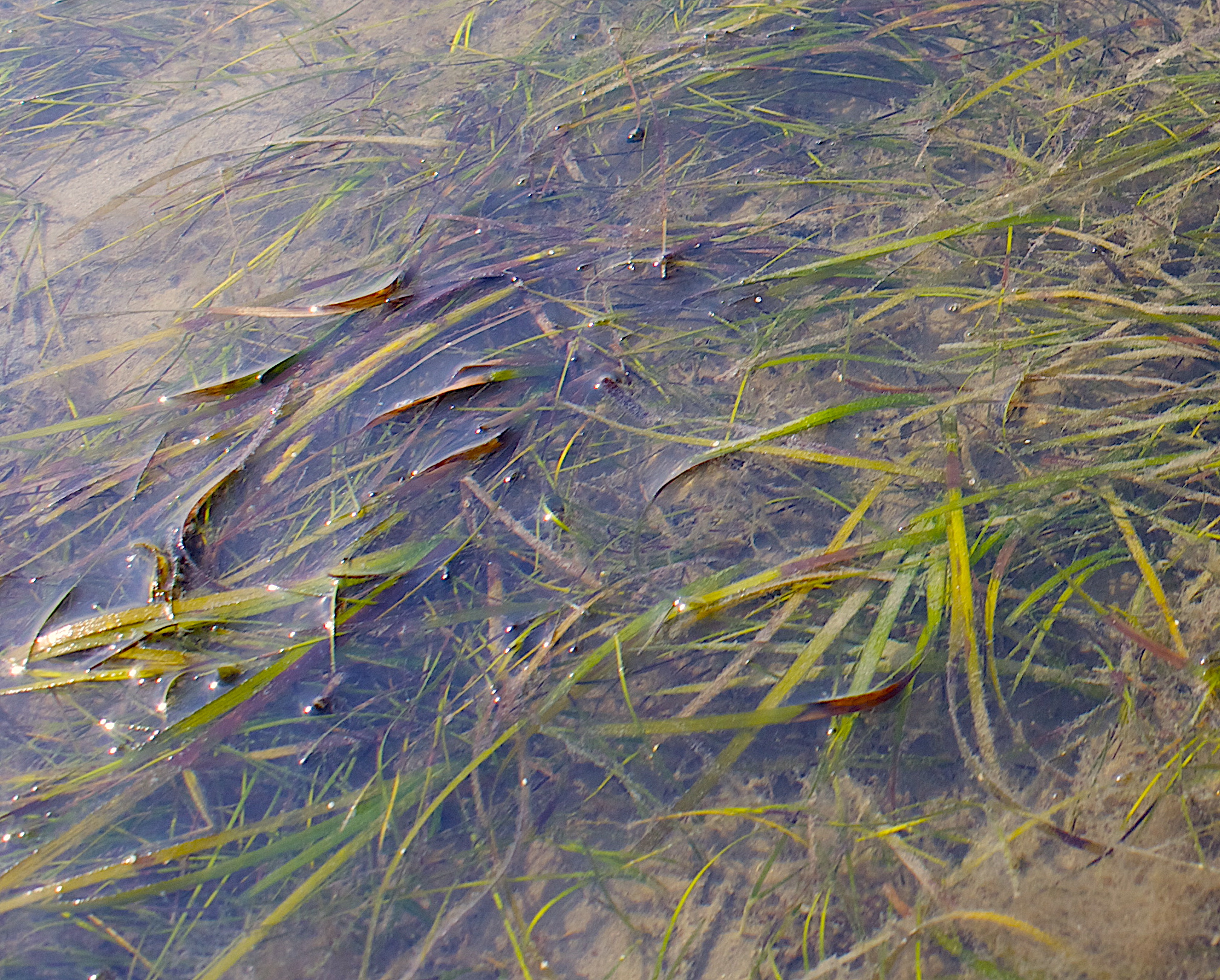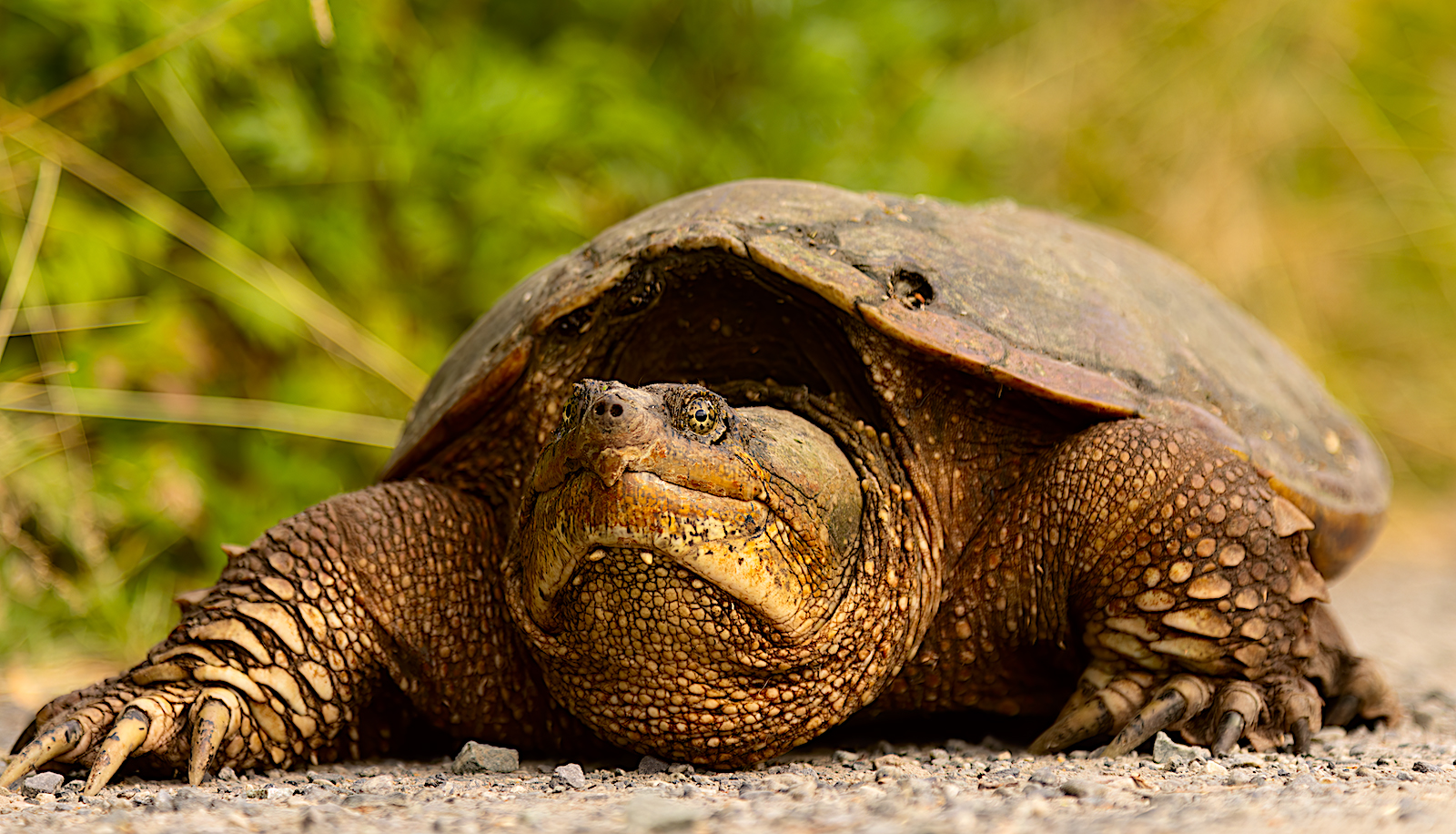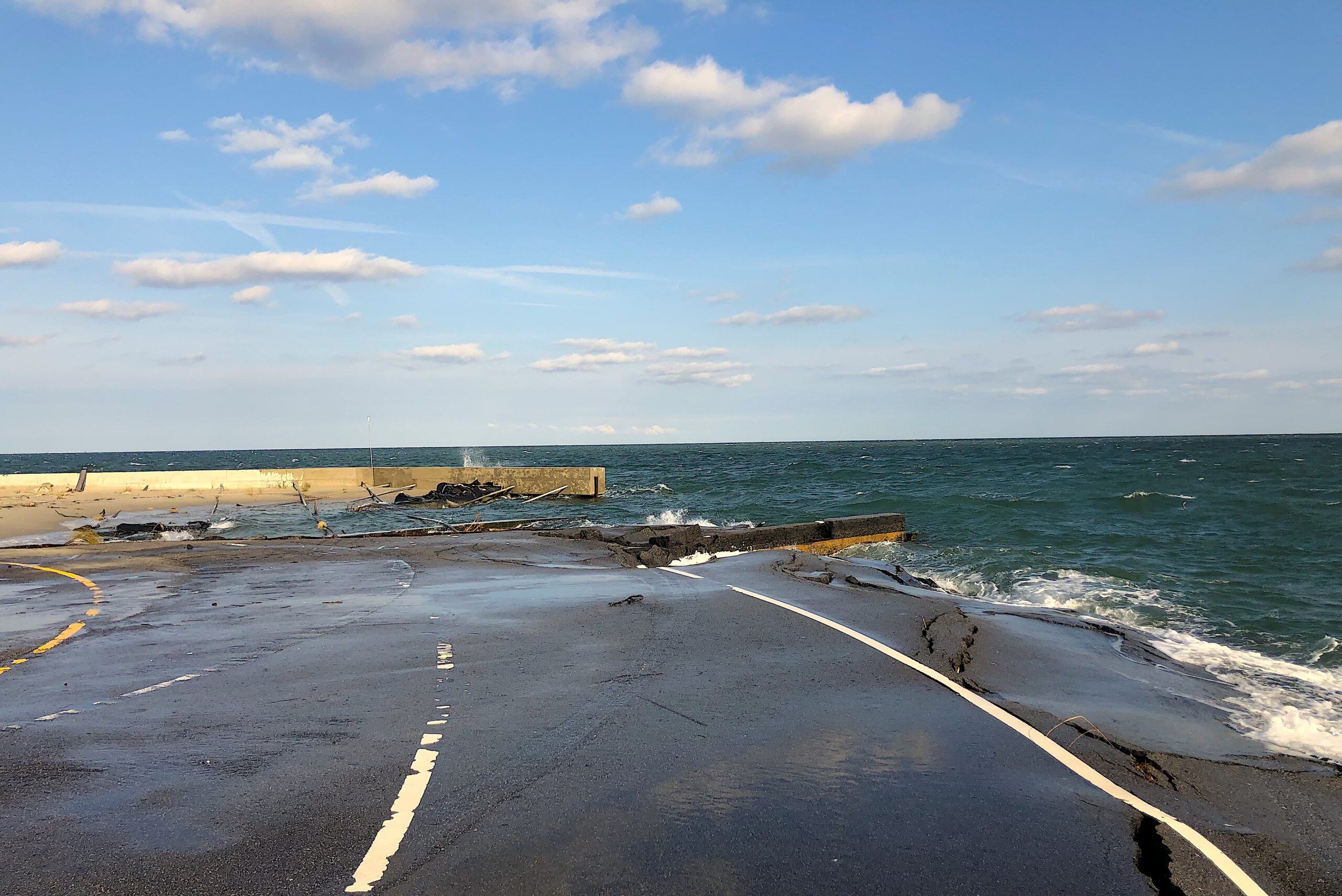Re-establishing Cordgrass: Fisheries’ Friend and Shoreline Protector

Just as Brad Marx is describing the variety of wildlife he often sees at the marina, a small green heron lands on a dock overlooking a strange floating contraption.
“He’s been coming here every day,” says Marx, owner of Mariner’s Cove Marina in Avon on Hatteras Island. He also points out a small blue crab swimming around the floats, which are tethered to the dock with a series of cables.
“We’re seeing a lot of activity around the area, but especially around the logs,” Marx explains.
The logs Marx refers to are “biologs.” Often used by the construction industry for erosion control, biologs are log-shaped rolls of coconut fiber material — called “coir,” pronounced CORE — wrapped in rope webbing. With money from the North Carolina Fishery Resource Grant Program (FRG), Marx is using biologs on modified oyster floats to grow Spartina alterniflora — or smooth cordgrass — a native grass essential to healthy salt marshes and wetland habitats. The FRG program is funded by the N.C. General Assembly and administered by Sea Grant.
Marx has lived around salt marshes all his life. Growing up in Lynnhaven, Va., and moving to Avon two years ago, Marx is an avid hiker, kayaker and recreational fisherman.
During his outdoor adventures, Marx has noticed detrimental effects of development and erosion on his familiar marshlands. Inspired by the idea of under-dock oyster floats, Marx decided to try and grow native marsh grasses in his marina’s waters in times when boat slips are not in use.
Anthony LeBude, a North Carolina State University nursery extension specialist and Marx’s friend since high school, provides scientific guidance for the project. LeBude’s primary objective is to help growers raise plants more sustainably, with limited nutrients and irrigation.
Using natural materials, such as biologs and fertilizer from fish-industry byproducts, Marx and LeBude’s project offers an alternative approach to traditional plant growth practices. Their methods eliminate the need for fresh water or expensive coastal real estate to grow the grasses.
Marsh Grass Benefits
Most people familiar with the North Carolina coast will recognize Spartina as the spiky, hard grass that grows along soundfronts. What they may not realize is how important the durable grass is in protecting salt marsh shorelines and establishing habitat for fisheries.
Spartina cordgrasses are the dominant plants of salt marshes and filter pollutants from overland runoff. They also protect shorelines and provide food and shelter to blue crabs, shrimp, southern flounder and many other commercially valuable finfish.
“Spartina is a tough grass. It can withstand periodic flooding, drought and salt water,” LeBude explains. “It’s the first line of defense in fisheries resource areas.”
“There is a direct link between abundance of Spartina and the health of fisheries,” adds
Sara Mirabilio, Sea Grant fisheries specialist. Spartina is arguably the primary habitat for many fishery nurseries, she explains.
Interestingly, the way the floats are set up seems to further enhance the Spartina’s ability to accommodate growing crabs and fish.
“Lots of fish come through the cages and form mini-nurseries which are protected by the cage,” explains LeBude.
Adult fishes, such as sea trout, red drum and flounder also prowl the edges of marshes feeding on shrimp, killifish and other prey hiding among the vegetation, according to the N.C. Division of Marine Fisheries’ Coastal Habitat Protection Plan.
Other species that live outside marsh habitats, like menhaden, use decaying organic material from marsh vegetation or microalgae produced on the marsh surface as a food source.
Cordgrasses also help control erosion, says Spencer Rogers, Sea Grant’s coastal construction and erosion specialist.
The grasses’ roots accumulate dead stems and sediment, building root mats that are one to two feet thick.
“This tough surface material can take a tremendous amount of wave pounding,” Rogers explains.
The thick root mats solidify to elevate marsh surfaces, which help protect upland areas from larger breaking waves. The grass stems also act as drag to reduce wave size and strength.
Rogers explains that about 20 feet of marsh is required for upland protection, and that many places experiencing heavy erosion are where marsh grasses have disappeared.
Restoring Salt Marshes
A low-impact option — second only to leaving land in its natural state — is to use vegetation control to stabilize estuarine shoreline, according to the 2006 report of the N.C. Estuarine Biological and Physical Processes Work Group’s Recommendations for Appropriate Shoreline Stabilization Methods.
The work group and the N.C. Division of Coastal Management prepared the report for the N.C. Coastal Resources Commission Estuarine Shoreline Stabilization Subcommittee.
“Typically, the number two recommendation is to use vegetation control because vegetation is a natural and environmentally beneficial stabilization method,” the report reads.
Seedlings are usually purchased from local or out-of-state nurseries and transplanted, but plants also may be grown from seeds in protected areas.
Rogers says planting marsh grasses is relatively affordable — a little less than 50 cents per plant.
But planting works best in salt marshes with low-energy waves. The strategy isn’t always as successful in areas frequently pounded by high-energy waves.
Shorelines with a longer fetch — or areas of water over which waves can build in height when pushed by wind — are more susceptible to erosion, Rogers explains. Waves can cause underwater erosion close to the shoreline, eventually allowing water to wash away soft sediment under the grasses’ root mats, and break their secure hold to shore.
To provide more stability in these areas, a combination of plantings and protective structures tends to work better, Rogers says.
In some cases, hard structures are placed offshore just above the high water line to protect establishing vegetation. Made of wood or stone, these “sill” structures are cheaper and have less environmental impact compared to larger breakwaters or bulkheads.
Enter biologs. These biodegradable structures can be staked down to serve a function similar to sills. The difference is that they are biodegradable, offering temporary protection for medium-energy environments while vegetation becomes established.
Rather than digging holes and planting seedlings on the shore behind biologs and other breakwaters, the pre-vegetated biologs from Marx’s project will be staked at the high-water line with the grasses growing right in them.
The goal: As the coir material in the biologs slowly decomposes, the root mats of the grasses will grow down and replace it. This method may be an effective solution in salt marshes that are fairly protected, but have steeper shorelines where traditional plantings may wash away.
Erin Fleckenstein, a coastal scientist at the N.C. Coastal Federation (NCCF) says there is potential for using Marx’s biologs for stabilization of the canal shoreline at Manteo’s future stormwater park or for the soundside “Living Shoreline” project NCCF is working on at Jockey’s Ridge State Park.
Backyard Biologs
For their research, Marx and LeBude constructed eight floats, each consisting of a 5- by 5-foot PVC pipe frame and an 8-inch-deep cage made of plastic-coated wire — modified versions of the Taylor float oyster containment system, developed and tested for oyster gardening by Jake Taylor of the Virginia Institute of Marine Science.
In early June, the team planted seedling plugs of Spartina alterniflora in each biolog. Each float consisted of four biologs. Two logs received grass seedlings spaced three inches apart, and two logs received seedlings spaced six inches apart. The floats sit in the water so that the tops of the biologs are above the surface.
On each float, Marx and LeBude used organic fish emulsion, a byproduct from the menhaden industry, as fertilizer on one biolog with three-inch spacing and one with six-inch spacing. They attached white zip ties to logs to identify plants that had received fertilizer.
Marx says that in severe weather, the floats can be rolled out of the water onto land. Marx will observe and record the number of new shoots, leaf spread and effectiveness of fertilizer through the late fall. He also plans to track costs to determine whether any enhanced growth from fertilizer or denser planting justifies corresponding costs.
The grasses from Marx’s project will spend the winter in their current location and then be used in an NCCF restoration project in the spring, when they will be most likely to survive transplant.
In the meantime, Marx and LeBude are brainstorming potential variations and improvements to the floating biolog method, including trying to plant Spartina seeds in the logs and using a lighter, low-maintenance coir net below instead of a cage.
Marx says that with new stormwater rules and increasing public interest in low-impact development, he expects an increased demand for local sources of cordgrasses. Whether alternative methods like his are viable for providing those sources will come down to weighing costs and benefits.
“Any way to reduce costs would translate into more acres of habitat restored,” Mirabilio says.
For more information on Fishery Resource Grant projects, go online to www.ncseagrant.org and follow links to research.
To learn more about fisheries habitats, go online to http://portal.ncdenr.org/web/mf/. Click on “CHPPs” for Coastal Habitat Protection Plans.
For additional resources on estuarine erosion causes, policy and management strategies, check out Sea Grant’s Soundfront Series, available online at ncseagrant.ncsu.edu.
To read Marx’s and LeBude’s Fishery Resource Grant report, visit ncseagrant.ncsu.edu and search for 08-EP-04.
This article was published in the Holiday 2008 issue of Coastwatch.
For contact information and reprint requests, visit ncseagrant.ncsu.edu/coastwatch/contact/.
- Categories:


